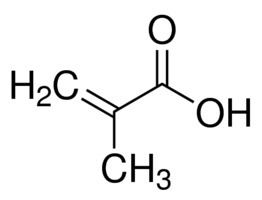Abbreviations MAA Formula C4H6O2 Boiling point 161 °C | Density 1.02 g/cm³ Molar mass 86.06 g/mol Melting point 15 °C | |
 | ||
Appearance Colorless liquid or solid | ||
Methacrylic acid meaning
Methacrylic acid, abbreviated MAA, is an organic compound. This colorless, viscous liquid is a carboxylic acid with an acrid unpleasant odor. It is soluble in warm water and miscible with most organic solvents. Methacrylic acid is produced industrially on a large scale as a precursor to its esters, especially methyl methacrylate (MMA) and poly(methyl methacrylate) (PMMA). The methacrylates have numerous uses, most notably in the manufacture of polymers with trade names such as Lucite and Plexiglas. MAA occurs naturally in small amounts in the oil of Roman chamomile.
Contents
Production and properties
More than 3 million tons of methyl methacrylate (MMA) are produced annually. In one route, acetone cyanohydrin is converted to methacrylamide sulfate using sulfuric acid. That compound is hydrolyzed to methacrylic acid, or it can be converted into methyl methacrylate in one step. In the second route, isobutylene or tert-butanol are oxidized to methacrolein, then methacrylic acid. Methacrolein for this purpose can also be obtained from formaldehyde and ethylene. Isobutyric acid can also be dehydrogenated to methacrylic acid.
Methacrylic acid was first obtained in the form of its ethyl ester by treating phosphorus pentachloride with oxyisobutyric ester (A synonym for beta-hydroxy-butyric acid or 3-hydroxybutyric acid) . It is, however, more readily obtained by boiling citra- or meso-brompyrotartaric acids with alkalis. It crystallizes in prisms. When fused with an alkali, it forms propanoic acid. Sodium amalgam reduces it to isobutyric acid. A polymeric form of methacrylic acid was described in 1880.
